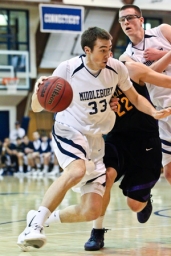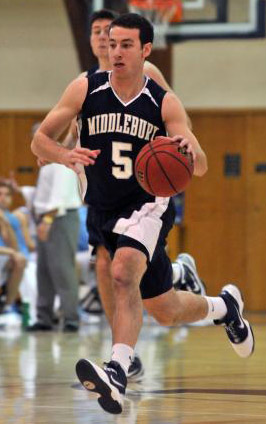There are three — and only three — possible candidates for Offensive Player of the Year in the NESCAC: Mac Foote (Middlebury), Zach Driscoll (Middlebury) and Evan Bunker (Trinity). Here are their respective 2012 season lines:
Mac Foote: 256-402 (64%, 32 completions/game, 1st in nation), NESCAC-record 2,897 yards (362/game, 3rd in nation), NESCAC-record 31 TD (3.9 TD/game, 2nd in nation), 8 INT
Zach Driscoll: NESCAC-record 83 receptions (10.4 receptions/game, 2nd in nation), 1,134 yards (141.75 yards/game, 2nd in nation), NESCAC-record 15 receiving TD (1.9 TD/game, 1st in nation)
Evan Bunker: 207 rushes, 1275 yards (159 yards/game, 3rd in nation), 6.16 yards/carry (21st in nation), 11 catches, 97 yards, 11 TD (27th in nation)
While Bunker certainly has a strong case for the award, his season simply does not measure up to those of Driscoll and Foote. Bunker is an incredible runner and in an ordinary year this would be his award, but what Driscoll and Foote accomplished this season cannot be ignored. Put simply, they both just finished the best single season in NESCAC history at their respective positions. Driscoll set the single season record for most receptions and touchdowns for a wide receiver and fell just four yards short of setting the receiving yards record. Mac set the single season record for passing yardage and obliterated the passing touchdown record, throwing 36% of the total touchdowns thrown in the conference this season.
Consider for a moment that Bunker averaged 159 yards per game on the ground — a very impressive, though not record-breaking number. Then consider that Driscoll nearly matched that through the air, nearly tripling the yards per game average of the next best non-Middlebury wide receiver. Bunker’s numbers, though again impressive, are considerably more reasonable when juxtaposed to those of the next best runners in the conference all of whom averaged nearly two-thirds of Bunker’s production. Driscoll also scored four more touchdowns than Bunker, despite less than half as many touches.
Some will argue that Bunker’s numbers were depressed by backfield mate Ben Crick who stole carries from Bunker, making Bunker’s season that much more impressive. There are two responses to this argument. First, if we acknowledge that Crick took carries away from Bunker, which he did (though Bunker still led the NESCAC in rushing attempts) then we must also acknowledge that Middlebury’s numerous weapons on the outside, including Chapman, Rankowitz, Goodkind and Minno also took targets away from Driscoll — probably at a considerably greater “cost” to Driscoll’s numbers than Crick’s affect on Bunker. And second, while we’re on the subject of Crick, doesn’t it say something that, of the two runners, Crick was both more efficient and more explosive than Bunker? On 84 carries (hardly a small sample size), Crick averaged better yards per carry average and a considerably higher touchdown rate than Bunker. This isn’t to say that Crick is the better of the two backs, but rather to point out that what Bunker accomplished was not so much more impressive than what other players on his team and in the conference accomplished. The same cannot be said about Driscoll or Foote, who statistically obliterated every other NESCAC player at their respective positions, this year or any year.
So, given that Driscoll and Foote both had seasons for the ages, which is more deserving? We would argue that their accomplishments cannot and should not be separated. Foote and Driscoll have had a special connection this season since the very first drop back (which happened to result in a Driscoll touchdown catch), one that has broken and set numerous program and conference records, and one that should result in the pair being named Co-Offensive Players of the Year. Furthermore, the fact that Driscoll and Foote played together should not weaken their case for Co-OPoY, but rather enhance it. This is not a case where the quarterback made the wide receiver or vice versa. Instead, the immense talent of each player allowed the other to play at a higher level than any other at their position. The 15 touchdowns that Foote threw to Driscoll this season were the product of precision route running and perfectly timed touch throws that could not have been, and were not, replicated by any other tandem in the league, including Driscoll’s teammates.
Zach Driscoll and Mac Foote should be named co-Offensive-Players-of-the-Year in the NESCAC, and both should be strongly considered for First Team All-American honors, along with tight end Billy Chapman.
The final argument for Bunker — that he outperformed Foote and Driscoll in their one meeting — is also a weak one. While Bunker was phenomenal in that game and both Foote and Driscoll played well below their capabilities, Bunker should not get credit for “outperforming” Middlebury’s stars. This is a nonsensical argument, similar to reasoning that the outcome of a pitching duel or the result of a game involving two great quarterbacks determines who the better player is. In reality, the Middlebury offense was dominated by the best defense in the NESCAC, and Bunker ran wild over a defense that regressed in the second half of the season, especially against the run. It does not make the case that Bunker was the superior offensive player.
Instead, it does, along with many other factors, make a great case for Trinity safety Rae Haynes as the Defensive Player of the Year. Haynes is as dominant of a player as there is in the conference and, we would argue, probably the best player at any position in the league. While his teammate Stephen Goniprow also has a strong case for DPoY and probably had a better statistical season than Haynes, stats account for a smaller piece of the puzzle on defense than they do on offense. Haynes made it virtually impossible to throw downfield against the Bantams, using both his imposing physicality and tremendous quickness to simultaneously intimidate receivers — often stopping their routes completing their routes — and dissuade quarterbacks from throwing the ball in his direction. Because measuring the effectiveness of a defensive player is understanding the importance of not just what did happen, but also what didn’t happen, it is Haynes who deserves the award for Defensive Player of the Year.
While offensive “matchups” are a foolish way to determine the better of the two players in any substantial way, the same cannot be said about coaching results. The NESCAC Coach of the Year, therefore, is a straightforward decision — the award belongs to Trinity head coach Jeff Devanney. While Bates head coach Mark Harriman is also deserving of the award, both for his team’s improvement as well as everything they accomplished this season in light of the terrible tragedy of Troy Pappas’s death, what Devanney did this year, blowing out certain teams, including Middlebury, with greater preparation and a better game plan while consistently pulling the right strings late in games when the team needed a big play was amazing. The criteria for great coaches should be threefold: 1) Earn the respect of and have the ability to motivate your players (check) 2) Consistently outcoach your competition with better preparation and game planning (check) 3) In tight games always put your team in the best possible position to win (check). Having clearly demonstrated that he excels in each of these respective areas, Devanney should be the decision for CoY despite considerable improvement from Middlebury, Wesleyan and Bates.


